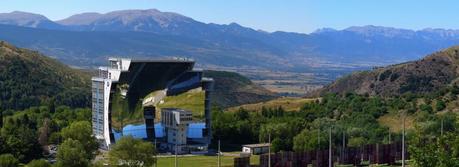 The solar furnace at Odeillo in the Pyrénées-Orientales in France can reach temperatures up to 3,500 °C (6,330 °F) (Credit: H. Zell http://en.wikipedia.org/wiki/File:Four_solaire_001.jpg)
The solar furnace at Odeillo in the Pyrénées-Orientales in France can reach temperatures up to 3,500 °C (6,330 °F) (Credit: H. Zell http://en.wikipedia.org/wiki/File:Four_solaire_001.jpg)Normally when we think of the sun, we think about light and maybe about heat. The sun’s good about doing both those things. Nowadays when we think about the sun we also think about solar power and how we can use the sun’s extra light to create electricity—usually through photovoltaics, but also through solar thermal power. But there are those who have come up with some truly unique applications to use the sun’s power.
Perhaps one of the most unique solar projects is the Solar Sinter. In 2011 artist Markus Kayser created the Solar Sinter, a solar powered three-dimensional printer that actually melts sand and sinters it into a form programmed into a computer. The apparatus Kayser created is powered with a photovoltaic panel and the sintering is done by a highly focussed Fresnel lens, which focuses the sunlight on one point of sand, making it hot enough to sinter it or melt and fuse the silicon in the sand into glass. How hot is that? About at least 2,192 degrees Fahrenheit.
So, since a simple Fresnel lens can produce that much heat, perhaps it’s not too surprising that solar power is also being used to smelter metal. In Font-Romeu-Odeillo-Via, in the Basque region of France the near Spain is the word’s largest solar furnace. Looking like a giant stage and the inside of a disco ball, solar furnace at Odeillo can reach temperatures of up to 6,330 degrees Fahrenheit. The structure uses about 10,000 mirrors to focus sunlight on an area about the size of a tea kettle and can be used for all sorts of things, from melting metal to making carbon nanotubes. It’s been there since the 1970s.
But using the sun’s heat also has more practical purposes (for most people), like in solar ovens. Solar ovens magnify the sun’s heat to a certain extent—certainly not as much as either the Solar Sinter or the solar furnace in France—but enough to cook food. Solar ovens have been used in places like Haiti as it recovers from the tragic earthquake in 2010, and in Africa, India and other developing nations to provide the ability to cook food without the need for additional fuel. Solar ovens help cut down on pollution, too, since users aren’t burning wood, cow pies or kerosene to provide the heat.
Almost as vital as the basic need to cook food is the need to make sure medical instruments are sterile. That’s why a solar-powered autoclave is drawing attention. The Solarclave developed by Rice University (MIT has also developed one) uses a parabolic mirror to focus sunlight on an apparatus that contains water or another aqueous solution and turns it into steam. The steam is then used to sterilize medical instruments providing an important tool, particularly in areas without ready access to electricity or other means of sterilizing medical instruments, so a solar autoclave can be used by medical professionals in developing nations and when traveling to villages to provide safe medical apparatuses where there’s no ready access to a traditional autoclave to sterilize them.
These are just a few of the non-traditional uses of solar power, another potential use of solar is to desalinize or purify water when needed, which can also help in developing nations and even in places like the U.S. when ready access to clean water is needed.
This article was originally posted on SolarReviews by Chris Meehan.

